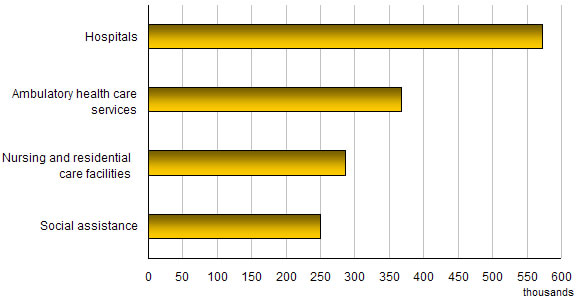Publications
The Canadian Labour Market at a Glance
Employees in health care and social assistance
Archived Content
Information identified as archived is provided for reference, research or recordkeeping purposes. It is not subject to the Government of Canada Web Standards and has not been altered or updated since it was archived. Please "contact us" to request a format other than those available.
Health care and social assistance employment continues to increase
-
Hospitals account for 39% of the employees in health care and social assistance and remain the largest employer in this sector. Following job losses in the 1990s, employment in the sector grew every year from 2000 to 2007, including a 2.2% gain in 2007, which brought employment to 572,400, approximately the same level as in 1990.
-
Ambulatory health care services, which includes services such as those provided in the offices of physicians, dentists and other health practitioners, remains the second-largest employer in health care and social assistance. In 2007, one in four health care and social assistance employees were in ambulatory health care services, up from one in five in 1991.
-
The upward trend in employment accelerated in nursing and residential care facilities, where increases of hundreds of jobs in 2004 and 2005 paled in comparison with gains of thousands of jobs, that is, 9,300 and 9,800 jobs in 2006 and 2007, respectively.
-
The employment level in social assistance rose 2.2% in 2007. Although social assistance remains the smallest component, it enjoyed the largest increase from 1991 to 2007 (96.9%). In particular, the number of employees in child daycare services more than doubled since 1991, reaching 92,900.
Chart E.6
Employees in health care and social assistance, 2007

Source: Statistics Canada, Survey of Employment, Payroll and Hours, CANSIM table 281-0024.
- Date modified:
